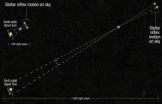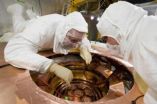(Press-News.org) Using NASA's Hubble Space Telescope, astronomers now can precisely measure the distance of stars up to 10,000 light-years away -- 10 times farther than previously possible.
Astronomers have developed yet another novel way to use the 24-year-old space telescope by employing a technique called spatial scanning, which dramatically improves Hubble's accuracy for making angular measurements. The technique, when applied to the age-old method for gauging distances called astronomical parallax, extends Hubble's tape measure 10 times farther into space.
"This new capability is expected to yield new insight into the nature of dark energy, a mysterious component of space that is pushing the universe apart at an ever-faster rate," said Noble laureate Adam Riess of the Space Telescope Science Institute (STScI) in Baltimore, Md.
Parallax, a trigonometric technique, is the most reliable method for making astronomical distance measurements, and a practice long employed by land surveyors here on Earth. The diameter of Earth's orbit is the base of a triangle and the star is the apex where the triangle's sides meet. The lengths of the sides are calculated by accurately measuring the three angles of the resulting triangle.
Astronomical parallax works reliably well for stars within a few hundred light-years of Earth. For example, measurements of the distance to Alpha Centauri, the star system closest to our sun, vary only by one arc second. This variance in distance is equal to the apparent width of a dime seen from two miles away.
Stars farther out have much smaller angles of apparent back-and-forth motion that are extremely difficult to measure. Astronomers have pushed to extend the parallax yardstick ever deeper into our galaxy by measuring smaller angles more accurately.
This new long-range precision was proven when scientists successfully used Hubble to measure the distance of a special class of bright stars called Cepheid variables, approximately 7,500 light-years away in the northern constellation Auriga. The technique worked so well, they are now using Hubble to measure the distances of other far-flung Cepheids.
Such measurements will be used to provide firmer footing for the so-called cosmic "distance ladder." This ladder's "bottom rung" is built on measurements to Cepheid variable stars that, because of their known brightness, have been used for more than a century to gauge the size of the observable universe. They are the first step in calibrating far more distant extra-galactic milepost markers such as Type Ia supernovae.
Riess and the Johns Hopkins University in Baltimore, Md., in collaboration with Stefano Casertano of STScI, developed a technique to use Hubble to make measurements as small as five-billionths of a degree.
To make a distance measurement, two exposures of the target Cepheid star were taken six months apart, when Earth was on opposite sides of the sun. A very subtle shift in the star's position was measured to an accuracy of 1/1,000 the width of a single image pixel in Hubble's Wide Field Camera 3, which has 16.8 megapixels total. A third exposure was taken after another six months to allow for the team to subtract the effects of the subtle space motion of stars, with additional exposures used to remove other sources of error.
Riess shares the 2011 Nobel Prize in Physics with another team for his leadership in the 1998 discovery the expansion rate of the universe is accelerating -- a phenomenon widely attributed to a mysterious, unexplained dark energy filling the universe. This new high-precision distance measurement technique is enabling Riess to gauge just how much the universe is stretching. His goal is to refine estimates of the universe's expansion rate to the point where dark energy can be better characterized.
INFORMATION:
The Hubble Space Telescope is a project of international cooperation between NASA and the European Space Agency. NASA's Goddard Space Flight Center in Greenbelt, Md., manages the telescope. STScI conducts Hubble science operations. STScI is operated for NASA by the Association of Universities for Research in Astronomy, Inc., in Washington.
For images and more information about Hubble, visit:
http://www.nasa.gov/hubble
NASA's Hubble extends stellar tape measure 10 times farther into space
2014-04-10
ELSE PRESS RELEASES FROM THIS DATE:
SU plays key role in search for elusive dark matter
2014-04-10
Physicist Richard Schnee hopes to find traces of dark matter by studying particles with low masses and interaction rates, some of which have never been probed before.
The ongoing search for invisible dark matter is the subject of a recent article involving physicists from Syracuse University's College of Arts and Sciences.
Research by Richard Schnee, assistant professor of physics, is referenced in Symmetry magazine, a joint publication of the Stanford Linear Accelerator Center in Palo Alto, Calif., and Fermilab in Batavia, Ill.
"Scientists looking for dark matter ...
SU geologists prove early Tibetan Plateau was larger than previously thought
2014-04-10
Earth scientists in Syracuse University's College of Arts and Sciences have determined that the Tibetan Plateau—the world's largest, highest, and flattest plateau—had a larger initial extent than previously documented.
Their discovery is the subject of an article in the journal Earth and Planetary Science Letters (Elsevier, 2014).
Gregory Hoke, assistant professor of Earth sciences, and Gregory Wissink, a Ph.D. student in his lab, have co-authored the article with Jing Liu-Zeng, director of the Division of Neotectonics and Geomorphology at the Institute for Geology, ...
SU professors test boundaries of 'new physics' with discovery of 4-quark hadron
2014-04-10
Physicists in Syracuse University's College of Arts and Sciences have helped confirm the existence of exotic hadrons—a type of matter that cannot be classified within the traditional quark model.
Their finding is the subject of a forthcoming article, prepared by the Large Hadron Collider beauty (LHCb) Collaboration at CERN in Geneva, Switzerland. (LHCb is a multinational experiment, designed to identify new forces and particles in the universe.) Tomasz Skwarnicki, professor of physics, is one of the paper's lead authors.
"We've confirmed the unambiguous observation ...
ACP offers policy recommendations for reducing gun-related injuries, deaths in US
2014-04-10
April 10, 2014 -- A new policy paper from the American College of Physicians (ACP) offers nine strategies to address the societal, health care, and regulatory barriers to reducing firearms-related violence, injuries, and deaths in the United States. Reducing Firearm-Related Injuries and Deaths in the United States is published today in the peer-reviewed medical journal, Annals of Internal Medicine.
Principal among ACP's nine strategic imperatives is the recommendation to approach firearm safety as a public health issue so that policy decisions are based on scientific ...
Single mothers don't delay marriage just to boost tax credit, study says
2014-04-10
MADISON, Wis. – When the Earned Income Tax Credit was expanded in 1993, supporters hoped it would reward poor parents for working while critics feared that it might discourage single mothers from marrying or incentivize women to have more children to boost their tax refund.
A new collaborative study done by the University of Wisconsin-Madison and Cornell University reveals the EITC has helped the working poor but hasn't affected personal choices.
Sarah Halpern-Meekin, assistant professor of human development and family studies and affiliate of the Institute for Research ...
Antennae help flies 'cruise' in gusty winds
2014-04-10
Due to its well-studied genome and small size, the humble fruit fly has been used as a model to study hundreds of human health issues ranging from Alzheimer's to obesity. However, Michael Dickinson, Esther M. and Abe M. Zarem Professor of Bioengineering at Caltech, is more interested in the flies themselves—and how such tiny insects are capable of something we humans can only dream of: autonomous flight. In a report on a recent study that combined bursts of air, digital video cameras, and a variety of software and sensors, Dickinson and his team explain a mechanism for ...
Enzyme revealed as promising target to treat asthma and cancer
2014-04-10
In experiments with mice, Johns Hopkins Kimmel Cancer Center scientists have identified an enzyme involved in the regulation of immune system T cells that could be a useful target in treating asthma and boosting the effects of certain cancer therapies.
In research described online April 6 in Nature Immunology, the investigators show that mice without the enzyme SKG1 were resistant to dust mite-induced asthma. And mice with melanoma and missing the enzyme, developed far fewer lung tumors—less than half as many—than mice with SKG1.
"If we can develop a drug that blocks ...
Researchers discover possible new target to attack flu virus
2014-04-10
Scientists at The University of Texas at Austin have discovered that a protein produced by the influenza A virus helps it outwit one of our body's natural defense mechanisms. That makes the protein a potentially good target for antiviral drugs directed against the influenza A virus.
Better antiviral drugs could help the millions of people annually infected by flu, which kills up to 500,000 people each year.
When an influenza virus infects a human cell, it uses some of the host's cellular machinery to make copies of itself, or replicate. In this study, the researchers ...
For sick, elderly patients, surgical decision making 'takes a village'
2014-04-10
Surgical decision making for sick, elderly patients should be orchestrated by a multidisciplinary team, including the patient, his or her family, the surgeon, primary care physician, nurses and non-clinicians, such as social workers, advocates Laurent G. Glance, M.D., in a perspective piece published in the New England Journal of Medicine.
For this group of patients, surgery can be very risky. Glance, professor and vice-chair for research in the Department of Anesthesiology at the University of Rochester School of Medicine and Dentistry believes a more patient-centered, ...
Medicare's flawed adjustment methodology poor way to spend billions
2014-04-10
Lebanon, N.H. (April 10, 2014) – The methodology Medicare uses to adjust the billions of dollars it pays health plans and hospitals to account for how sick their patients are is flawed and should be replaced, according to a new study by Dartmouth investigators published in the journal BMJ that weighed the performance of Medicare's methodology against alternatives.
The researchers from the Dartmouth Atlas Project compared Medicare's current risk-adjustment methodology, which is based on the diagnoses recorded in patients' claims records, against adjustment indices based ...




